On April 10th, 1912, boarding the R.M.S ‘Titanic’ on a crisp, cloudy April day in Southampton, England, was a thirty-two year old man with a passion for photography studying to become a Jesuit Priest. While stepping on the gangway that would take him on board, he took out his camera, and looked to his right, taking a photo, one of many that he would take on board the fateful voyage. Yet who was this man? And why is he such an important part to the story of the Titanic?
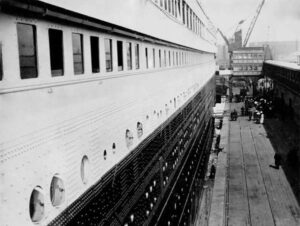
Early Life of Fr. Browne
Concerning the life of Fr. Browne, he had been born to a wealthy family on January 3rd, 1880 in Cork, Ireland. His mother, Brigid Browne (née Hegarty), was the daughter of the Lord Mayor of Cork, however, she would sadly perish a mere eight days after his birth due to puerperal fever. Tragically, Browne would suffer another tragedy as his father, James Browne, died in 1889 in a swimming accident. Due to this, care of the then nine-year-old Browne went to his uncle, Robert Browne, who was the Bishop of Cloyne at the time.
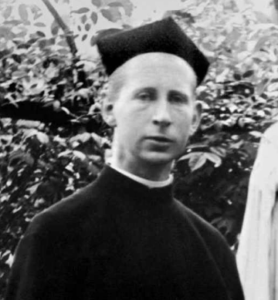
From here, Fr. Browne’s journey towards priesthood and photography would begin, going through three Catholic schools, the first being being Belvedere College, a Jesuit boys school in Dublin, Ireland from 1891-1892. Second, was Christian Brothers College in Cork, Ireland, which he would attend from 1892-1893, and finally, St. Vincent’s Castleknock College of Dublin, from 1893-1897. It would be in 1897, that his uncle Robert, gifted to him his very first camera, while from a modern standpoint, a camera would be a meager gift, for 1897, the case was far more exciting…
At the time, most cameras were large, bulky, and having a photograph taken was a formal occasion, with personal cameras being a rarity, meaning that Browne’s camera was a subject of fascination at the time, and one of, if not the most coveted items a person could own. It would be during a trip across Europe, that Browne would put his camera to use for the first time, extending his passion for photography.
Following returning to Ireland from Europe, Browne would officially join the Jesuits, novitiate at St. Stanislaus College in Tullabeg, Ireland. In the following years, he would attend the Royal University of Dublin, Ireland. Then, in 1911, he would begin studying Theology at Milltown Institute of Theology & Philosophy in Dublin, with the intention of taking up priesthood, in similar fashion to his uncle and brother both being bishops.
On Board R.M.S ‘Titanic’
In April of 1912, Browne would receive an exciting gift from his uncle, that being, a ticket on board the largest ship in the world, and darling of the White Star Line, the R.M.S ‘Titanic’s maiden voyage. Browne’s ticket, would give him first-class passage on board the Titanic from Southampton, England, to Queenstown, Ireland, which was scheduled as Titanic’s final port of call before sailing to New York City. Although he would not be on board the main voyage to New York, to sail on board a vessel like the Titanic, was a fascinating experience.
Browne, who was in Liverpool at the time, would travel to Southampton, and would board the Titanic on April 10th. Here, through his photos, Browne gives us a perfect view as to what it would have been like to be on board the Titanic during the first leg of her first and final voyage. Upon boarding, Browne was accompanied by a friend, Tom Brownrigg who had come to see him off. Upon boarding the Titanic, the two explored the vessel, including Browne’s cabin, A-37, which he took a photo of with his camera. Cabin A-37 is a particularly interesting cabin, as it contained its own private bathroom, something rarely seen on ships at the time. Next to A-37, was also Cabin A-36, which Titanic’s designer, Mr. Thomas Andrews stayed in.
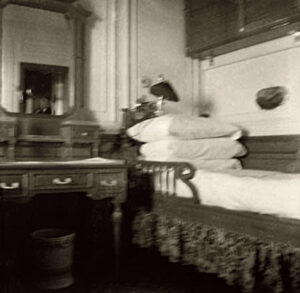
Shortly after, Titanic would depart Southampton, with Brownrigg saying bye to Browne, and Titanic sailing off. Titanic’s maiden voyage was scheduled to span seven days, with her departing Southampton on April 10th for Cherbourg, France, where she would pick up passengers and mail. From there, she would sail to Queenstown, Ireland, where more mail and passengers would be picked up. Then, Titanic would sail to New York City to complete the crossing. In this time, Browne would explore the ship, and took various photos that would be some of the most important in the history of the Titanic. As Titanic left Southampton, her propellers proved to be so powerful, that they caused a smaller, nearby liner the S.S ‘New York’, to be drawn into her path, almost causing a collision, yet this was thankfully averted. The incident was captured by Browne on his camera.
Concerning photos of the Titanic’s interior, they are overall rare and scarce, with very few being taken. In fact, if you search ‘RMS Titanic interior’, it is most likely not of the Titanic, but rather her older identical sister-ship, Olympic. This is because since both Olympic & Titanic were virtually identical, it meant that the White Star Line had no need to take more photos of Titanic’s interior, save for any photos for advertising. Because of this, there are no photos of areas like Titanic’s iconic grand staircase.
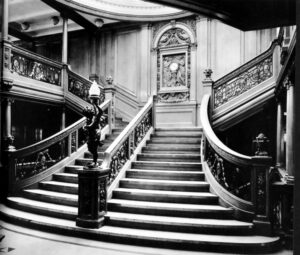
With photos of the Titanic’s interior being so scarce, it is no question as to why Browne’s photos are so important. While on board the Titanic, during a meal within Titanic’s dining room, he took the sole photo in existence of the Titanic’s dining room.
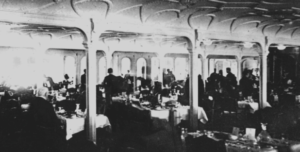
Shortly after, Titanic would arrive at her first destination, Cherbourg, France, where she would take on more passengers and mail. Her stay in Cherbourg was brief, with her departing quickly, sailing onto Queenstown, Ireland. During this time, Browne would meet a couple from America, who he quickly become acquainted with. This couple, would take a liking to Browne, and wishing to spend more time with him, offered to pay for him to stay on board the ship. Delighted, Browne appeared to accept, but first he would need to contact his superiors.
Luckily, this could be done by transmitting a telegraph message, which was available to passengers. For a passenger to transmit a telegraph message on the Titanic, it was only available to first-class passengers. First, they would go to the Purser’s Office on C-Deck, where they would tell the Purser what they wanted to send. Then, the Purser would put the message into a pipe, with that pipe then sucking it up the decks, and to the Wireless Room, where the telegraph was. Then, the message would be sent, and the Purser would then tell the passenger what the response was. Browne would do this, but he would be allowed to visit the telegraph room itself, a true privilege.
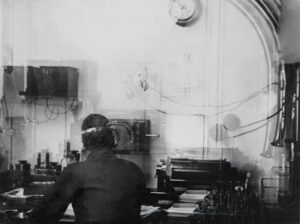
However, the response from his superiors was rather quick and cold, stating, “GET OFF THAT SHIP”, was this an omen to the fate of the Titanic? Either way, Browne would not be allowed to remain on board the Titanic, and would disembark at Queenstown. This, may have saved his life.
Leaving the Titanic
On April 11th, Titanic would arrive at her second destination of Queenstown in the morning, and would see land for the final time. Here, Browne would bid his farewells to those he had met on board, and would board one of the smaller ships assigned to disembark passengers from the Titanic. Here, Browne would take the final photo of Titanic’s captain, Captain Smith.
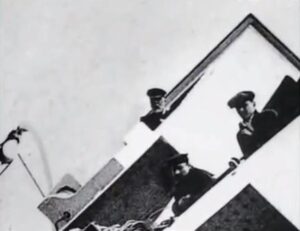
As he left the Titanic, Browne would take some of the final photos of the Titanic, and, eerily, a photo of the exact spot on the Titanic where the iceberg would impact a mere four days later.
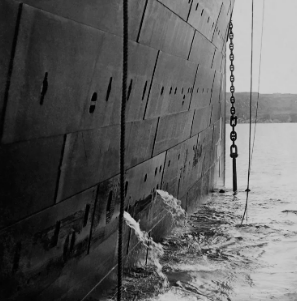
Shortly after, Titanic would depart Queenstown, to her doom. At about this time, Titanic has 2,200 souls on board, only about 700 will survive. As Titanic left Queenstown, Browne would take what would be the final photo ever taken of Titanic afloat.

After the Titanic
After leaving the Titanic, Browne would return to Dublin to continue his theology studies. Upon learning of the Sinking of the Titanic, he knew that his photographs would be a subject of importance to newspapers, leading to him selling them to newspapers and photography agencies, with the Kodak company giving him free film for life after receiving the photos.
Later Life
During World War I, in 1915, Browne would complete his studies and would be officially ordained as a Jesuit priest, becoming Father Francis Browne. Fr. Browne would then be sent to the battlefields of World War I as a chaplain for the Irish Guards regiment.
In the war, Browne would be severely injured numerous times, being awarded the Military Cross, and a bar (second award) to the cross. He would also receive French awards, such as the Croix de Guerre.
After World War I, he would become a superior of the Gardiner Street Church, yet soon he would fall sick, and it was decided to send him to Australia, as it was believed warmer climates would assist him in recovery in 1922. During his time in Australia, he persisted in preaching, and photography, and during his return to Ireland he would visit many British colonies such as Sri Lanka and Aden.
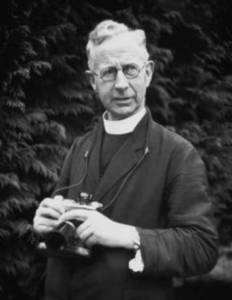
Upon returning to Ireland, he was appointed to the Retreats and Mission staff of the Jesuits of Ireland, which meant he would preach at missions and religious retreats throughout Ireland. This would continue for years until finally, in 1960, Fr. Browne would die peacefully, being buried Glasnevin Cemetery, Dublin, in the Jesuit’s Plot. His photos would be sadly forgotten, until being rediscovered in 1985 by Fr. Edward E. O’Donnell SJ, and in the coming years, his photos, including his Titanic photos, would be published.
Fr. Browne’s life saw him live in two centuries. When he first began taking photographs, it was of schooners in Irish harbors, yet by the end of his life, his photos were of jet aircraft that as a child he could never imagine. Through it all, his work as a photographer displays him as a contributor to the documentation of the world’s vast history, and his work as a Priest shows him as a servant of God.
